Mingyang Liu
KLIPA: A Knowledge Graph and LLM-Driven QA Framework for IP Analysis
Sep 09, 2025Abstract:Effectively managing intellectual property is a significant challenge. Traditional methods for patent analysis depend on labor-intensive manual searches and rigid keyword matching. These approaches are often inefficient and struggle to reveal the complex relationships hidden within large patent datasets, hindering strategic decision-making. To overcome these limitations, we introduce KLIPA, a novel framework that leverages a knowledge graph and a large language model (LLM) to significantly advance patent analysis. Our approach integrates three key components: a structured knowledge graph to map explicit relationships between patents, a retrieval-augmented generation(RAG) system to uncover contextual connections, and an intelligent agent that dynamically determines the optimal strategy for resolving user queries. We validated KLIPA on a comprehensive, real-world patent database, where it demonstrated substantial improvements in knowledge extraction, discovery of novel connections, and overall operational efficiency. This combination of technologies enhances retrieval accuracy, reduces reliance on domain experts, and provides a scalable, automated solution for any organization managing intellectual property, including technology corporations and legal firms, allowing them to better navigate the complexities of strategic innovation and competitive intelligence.
PIVOTS: Aligning unseen Structures using Preoperative to Intraoperative Volume-To-Surface Registration for Liver Navigation
Jul 27, 2025
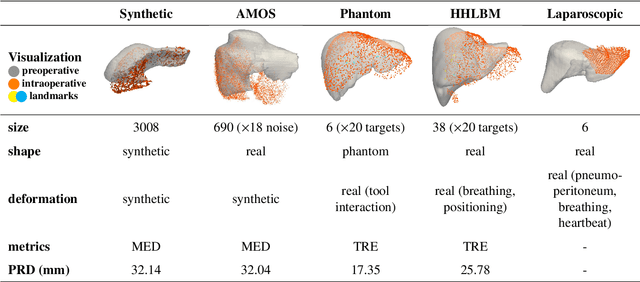
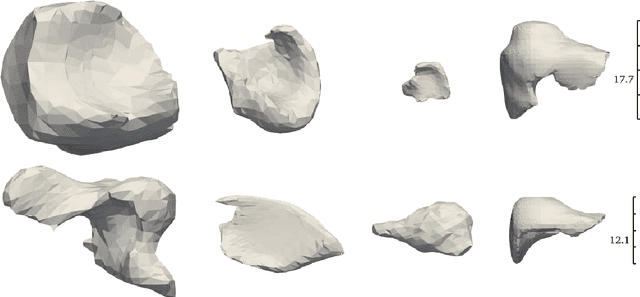
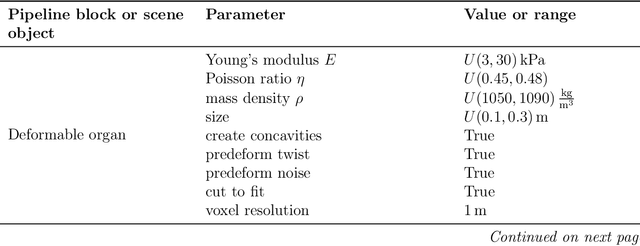
Abstract:Non-rigid registration is essential for Augmented Reality guided laparoscopic liver surgery by fusing preoperative information, such as tumor location and vascular structures, into the limited intraoperative view, thereby enhancing surgical navigation. A prerequisite is the accurate prediction of intraoperative liver deformation which remains highly challenging due to factors such as large deformation caused by pneumoperitoneum, respiration and tool interaction as well as noisy intraoperative data, and limited field of view due to occlusion and constrained camera movement. To address these challenges, we introduce PIVOTS, a Preoperative to Intraoperative VOlume-To-Surface registration neural network that directly takes point clouds as input for deformation prediction. The geometric feature extraction encoder allows multi-resolution feature extraction, and the decoder, comprising novel deformation aware cross attention modules, enables pre- and intraoperative information interaction and accurate multi-level displacement prediction. We train the neural network on synthetic data simulated from a biomechanical simulation pipeline and validate its performance on both synthetic and real datasets. Results demonstrate superior registration performance of our method compared to baseline methods, exhibiting strong robustness against high amounts of noise, large deformation, and various levels of intraoperative visibility. We publish the training and test sets as evaluation benchmarks and call for a fair comparison of liver registration methods with volume-to-surface data. Code and datasets are available here https://github.com/pengliu-nct/PIVOTS.
UFT: Unifying Supervised and Reinforcement Fine-Tuning
May 22, 2025



Abstract:Post-training has demonstrated its importance in enhancing the reasoning capabilities of large language models (LLMs). The primary post-training methods can be categorized into supervised fine-tuning (SFT) and reinforcement fine-tuning (RFT). SFT is efficient and well-suited for small language models, but it may lead to overfitting and limit the reasoning abilities of larger models. In contrast, RFT generally yields better generalization but depends heavily on the strength of the base model. To address the limitations of SFT and RFT, we propose Unified Fine-Tuning (UFT), a novel post-training paradigm that unifies SFT and RFT into a single, integrated process. UFT enables the model to effectively explore solutions while incorporating informative supervision signals, bridging the gap between memorizing and thinking underlying existing methods. Notably, UFT outperforms both SFT and RFT in general, regardless of model sizes. Furthermore, we theoretically prove that UFT breaks RFT's inherent exponential sample complexity bottleneck, showing for the first time that unified training can exponentially accelerate convergence on long-horizon reasoning tasks.
Activation-Guided Consensus Merging for Large Language Models
May 20, 2025Abstract:Recent research has increasingly focused on reconciling the reasoning capabilities of System 2 with the efficiency of System 1. While existing training-based and prompt-based approaches face significant challenges in terms of efficiency and stability, model merging emerges as a promising strategy to integrate the diverse capabilities of different Large Language Models (LLMs) into a unified model. However, conventional model merging methods often assume uniform importance across layers, overlooking the functional heterogeneity inherent in neural components. To address this limitation, we propose \textbf{A}ctivation-Guided \textbf{C}onsensus \textbf{M}erging (\textbf{ACM}), a plug-and-play merging framework that determines layer-specific merging coefficients based on mutual information between activations of pre-trained and fine-tuned models. ACM effectively preserves task-specific capabilities without requiring gradient computations or additional training. Extensive experiments on Long-to-Short (L2S) and general merging tasks demonstrate that ACM consistently outperforms all baseline methods. For instance, in the case of Qwen-7B models, TIES-Merging equipped with ACM achieves a \textbf{55.3\%} reduction in response length while simultaneously improving reasoning accuracy by \textbf{1.3} points. We submit the code with the paper for reproducibility, and it will be publicly available.
SAM2-ELNet: Label Enhancement and Automatic Annotation for Remote Sensing Segmentation
Mar 16, 2025Abstract:Remote sensing image segmentation is crucial for environmental monitoring, disaster assessment, and resource management, directly affecting the accuracy and efficiency of surface information extraction. The performance of existing supervised models in remote sensing image segmentation tasks highly depends on the quality of label data. However, current label data mainly relies on manual annotation, which comes with high time costs and is subject to subjective interference, resulting in distortion of label boundaries and often a loss of detail. To solve the above problems, our work proposes an Edge-enhanced Labeling Network, called SAM2-ELNet, which incorporates a labeling module and an edge attention mechanism. This model effectively addresses issues such as label detail loss, fragmentation, and inaccurate boundaries. Due to the scarcity of manually annotated remote sensing data, the feature extraction capabilities of traditional neural networks are limited. Our method uses the Hiera backbone of the pre-trained self-supervised large model segment anything model 2 (SAM2) as the encoder, achieves high-quality and efficient feature extraction even with small samples by fine-tuning on downstream tasks. This study compared the training effects of original and enhanced labels on the manually annotated Deep-SAR Oil Spill (SOS) dataset. Results showed that the model trained with enhanced labels performed better and had a lower final loss, indicating closer alignment with the real data distribution. Our work also explores the potential of extending the model into an efficient automatic annotation framework through generalization experiments, facilitating large-scale remote sensing image interpretation and intelligent recognition.
Differentially Private Equilibrium Finding in Polymatrix Games
Mar 12, 2025



Abstract:We study equilibrium finding in polymatrix games under differential privacy constraints. To start, we show that high accuracy and asymptotically vanishing differential privacy budget (as the number of players goes to infinity) cannot be achieved simultaneously under either of the two settings: (i) We seek to establish equilibrium approximation guarantees in terms of Euclidean distance to the equilibrium set, and (ii) the adversary has access to all communication channels. Then, assuming the adversary has access to a constant number of communication channels, we develop a novel distributed algorithm that recovers strategies with simultaneously vanishing Nash gap (in expected utility, also referred to as exploitability and privacy budget as the number of players increases.
DiffETM: Diffusion Process Enhanced Embedded Topic Model
Jan 01, 2025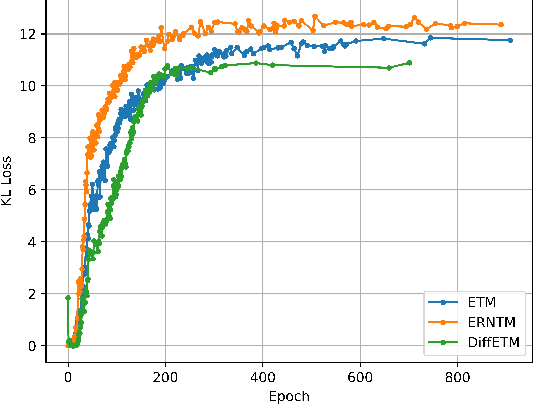
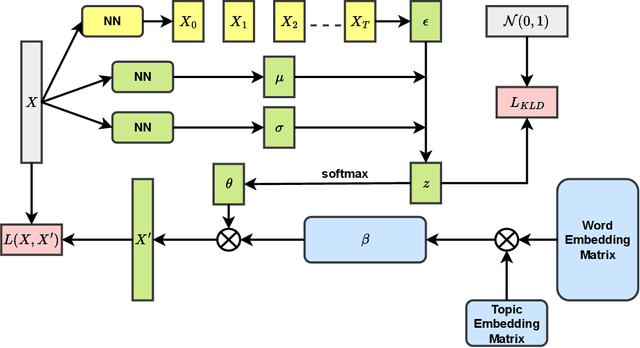
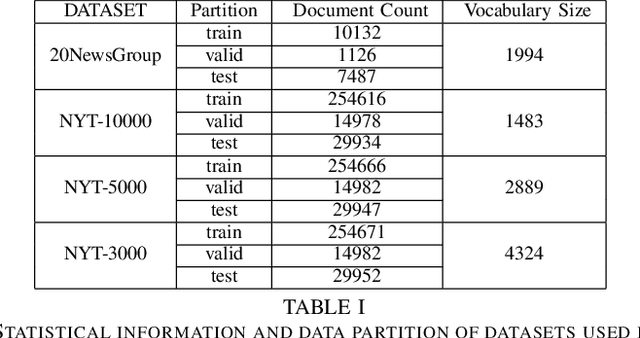

Abstract:The embedded topic model (ETM) is a widely used approach that assumes the sampled document-topic distribution conforms to the logistic normal distribution for easier optimization. However, this assumption oversimplifies the real document-topic distribution, limiting the model's performance. In response, we propose a novel method that introduces the diffusion process into the sampling process of document-topic distribution to overcome this limitation and maintain an easy optimization process. We validate our method through extensive experiments on two mainstream datasets, proving its effectiveness in improving topic modeling performance.
UniRiT: Towards Few-Shot Non-Rigid Point Cloud Registration
Oct 30, 2024Abstract:Non-rigid point cloud registration is a critical challenge in 3D scene understanding, particularly in surgical navigation. Although existing methods achieve excellent performance when trained on large-scale, high-quality datasets, these datasets are prohibitively expensive to collect and annotate, e.g., organ data in authentic medical scenarios. With insufficient training samples and data noise, existing methods degrade significantly since non-rigid patterns are more flexible and complicated than rigid ones, and the distributions across samples are more distinct, leading to higher difficulty in representation learning with few data. In this work, we aim to deal with this challenging few-shot non-rigid point cloud registration problem. Based on the observation that complex non-rigid transformation patterns can be decomposed into rigid and small non-rigid transformations, we propose a novel and effective framework, UniRiT. UniRiT adopts a two-step registration strategy that first aligns the centroids of the source and target point clouds and then refines the registration with non-rigid transformations, thereby significantly reducing the problem complexity. To validate the performance of UniRiT on real-world datasets, we introduce a new dataset, MedMatch3D, which consists of real human organs and exhibits high variability in sample distribution. We further establish a new challenging benchmark for few-shot non-rigid registration. Extensive empirical results demonstrate that UniRiT achieves state-of-the-art performance on MedMatch3D, improving the existing best approach by 94.22%.
Determine-Then-Ensemble: Necessity of Top-k Union for Large Language Model Ensembling
Oct 03, 2024



Abstract:Large language models (LLMs) exhibit varying strengths and weaknesses across different tasks, prompting recent studies to explore the benefits of ensembling models to leverage their complementary advantages. However, existing LLM ensembling methods often overlook model compatibility and struggle with inefficient alignment of probabilities across the entire vocabulary. In this study, we empirically investigate the factors influencing ensemble performance, identifying model performance, vocabulary size, and response style as key determinants, revealing that compatibility among models is essential for effective ensembling. This analysis leads to the development of a simple yet effective model selection strategy that identifies compatible models. Additionally, we introduce the \textsc{Uni}on \textsc{T}op-$k$ \textsc{E}nsembling (\textsc{UniTE}), a novel approach that efficiently combines models by focusing on the union of the top-k tokens from each model, thereby avoiding the need for full vocabulary alignment and reducing computational overhead. Extensive evaluations across multiple benchmarks demonstrate that \textsc{UniTE} significantly enhances performance compared to existing methods, offering a more efficient framework for LLM ensembling.
GERA: Geometric Embedding for Efficient Point Registration Analysis
Oct 01, 2024Abstract:Point cloud registration aims to provide estimated transformations to align point clouds, which plays a crucial role in pose estimation of various navigation systems, such as surgical guidance systems and autonomous vehicles. Despite the impressive performance of recent models on benchmark datasets, many rely on complex modules like KPConv and Transformers, which impose significant computational and memory demands. These requirements hinder their practical application, particularly in resource-constrained environments such as mobile robotics. In this paper, we propose a novel point cloud registration network that leverages a pure MLP architecture, constructing geometric information offline. This approach eliminates the computational and memory burdens associated with traditional complex feature extractors and significantly reduces inference time and resource consumption. Our method is the first to replace 3D coordinate inputs with offline-constructed geometric encoding, improving generalization and stability, as demonstrated by Maximum Mean Discrepancy (MMD) comparisons. This efficient and accurate geometric representation marks a significant advancement in point cloud analysis, particularly for applications requiring fast and reliability.
 Add to Chrome
Add to Chrome Add to Firefox
Add to Firefox Add to Edge
Add to Edge